#circa 1849
Text
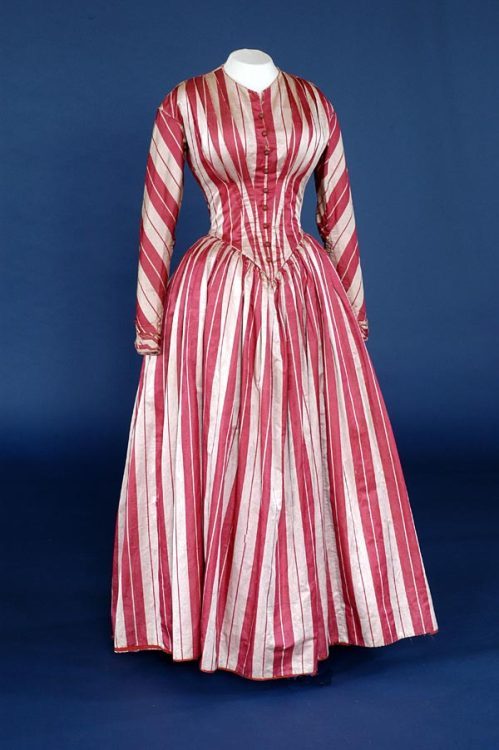
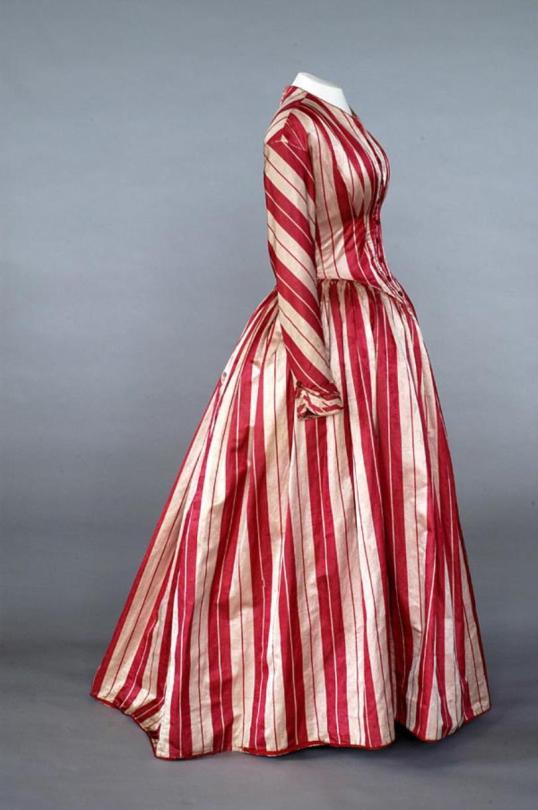
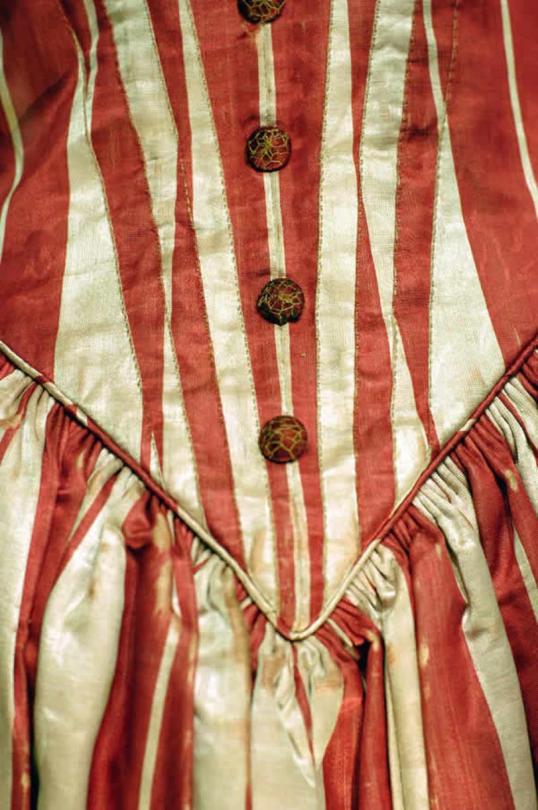
I can practically smell the candy cane on this British dress from 1849! Surprise, though--it isn't a holiday gown... it's a wedding gown!
As many folks know, the concept of the white wedding dress is fairly modern, dating to the middle of the 19th century. And even then, it wasn't ubiquitous. Wedding gowns weren't the "wear it once" they are today, and many women sought to find dresses they could later incorporate into their wardrobes. Even my grandmother, who married in the 1940s, wore a brown dress for her wedding. Part of that was a financial decision, of course, but I love the idea of colorful, practical wedding wear, too.
This dress is silk damask, which is always exciting for me. That means the pattern is reversible! Not something you would notice by just looking at it.
In classic 1840-1850 transitional wear, it's got a lot going for it: the very tailored waist looks very 1880s, while the silhouette is firmly in the 1840s. Those candy cane arms, though!
From the Bowes Museum.
#fashion history#costume#textiles#historical costuming#victorian fashion#silk dress#costume history#threadtalk#striped#circa 1849#circa 1840s#holiday gown
2K notes
·
View notes
Text



La passeggiata Anita Garibaldi a Genova Nervi è uno dei luoghi più suggestivi della città.
Immersa nella natura, offre un panorama mozzafiato sul mare e sulle colline circostanti.
La passeggiata prende il nome dalla celebre moglie di Giuseppe Garibaldi che qui soggiornò nel 1849.
Un percorso panoramico di circa due chilometri che parte dal Porticciolo di Nervi e arriva fino alla spiaggia di Capolungo.
Il sentiero è immerso nella vegetazione mediterranea e offre uno spettacolo unico sulla costa ligure, con i suoi colori, profumi intensi e una storia da raccontare...
23 notes
·
View notes
Photo
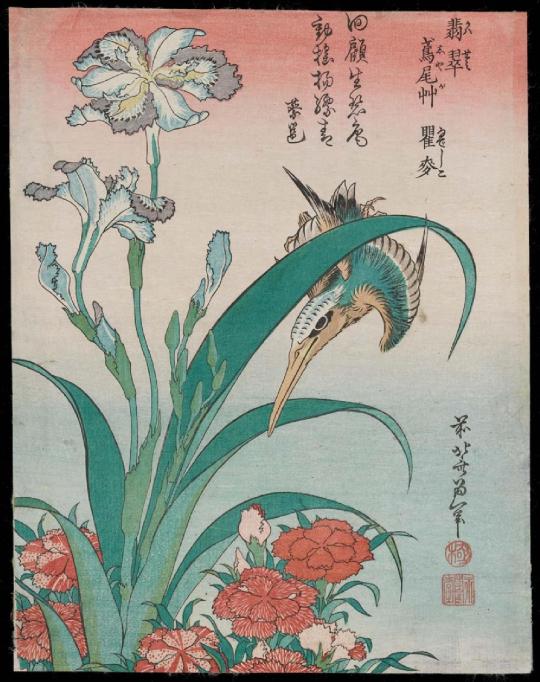
Kingfisher with Iris and Wild Pinks (circa 1834) by Katsushika Hokusai (Japanese, 1760–1849).
Woodblock print.
Image and text information courtesy MFA Boston.
219 notes
·
View notes
Photo

Hokusai (1760-1849), "Little Crow", Sword of Minamoto (Minamoto: Kokarasumaru no Hitokishi), circa 1822, woodblock print, 8.25 x 7.25 in. (20.96 x 18.42 cm), Ex. Collection Louis Gonce
720 notes
·
View notes
Text
A Genova, dopo il sacco del 1849 per reprimere i moti mazziniani, i bersaglieri dovettero aspettare il 1994 prima di poter partecipare a un evento pubblico in città.
Con queste premesse, direi che non ci si debba stupire se ancora per 120 anni circa a qualcuno faccia impressione l’idea che la polizia entri alle scuole Pertini-Diaz.
23 notes
·
View notes
Note
I'm thinking of getting a mid-19th century man after a friend got one, but I want to make sure I'm fully prepared to care for him properly. I've done some research, but are there any common misconceptions I should be aware of?
A mid-19th century man is a wonderful choice! And I'm glad that you want to care for him properly and research his needs, because "A Christmas Carol" notwithstanding, everyone always wants a Mr. Darcy or a Sherlock Holmes and not a man from the great checked and plaid expanse of Early Victorians.

A bonded pair circa 1845.
Here are some common misconceptions about mid-19th century men:
He DOES take baths and showers.

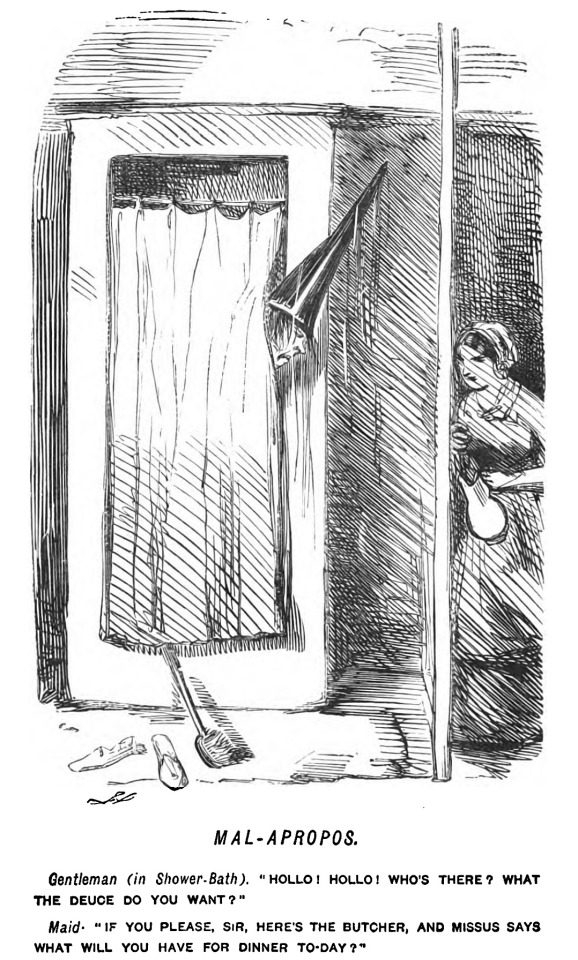
"Nothing like Warm Bathing" (1846), and "Mal-Apropos" (1849), both by John Leech. Hot water on tap is pretty unusual, but he will still be familiar with bath tubs that look a lot like the one in your home. For a (probably cold) shower-bath, he will want a conical oil-skin cap to protect his hair, as shown. The stereotype that 19th men love tall hats is really true; also he will probably perceive a modern shower cap as being something for women from its shape.
He's not that innocent (even if he pretends to be).
The whole "prudish Victorian" thing is massively overstated. Even if he's a well-bred mid-19th century man, he probably knows many dirty songs from flash songsters.
He has an elaborate sense of dressing correctly for the occasion (morning dress, sporting dress, and evening costume are not interchangeable); but he is not going to swoon at the sight of a lady's bare ankle, please. He is familiar with skimpy theatrical costumes and classical statuary; and be prepared to get him tested if you find a "swell's night guide."
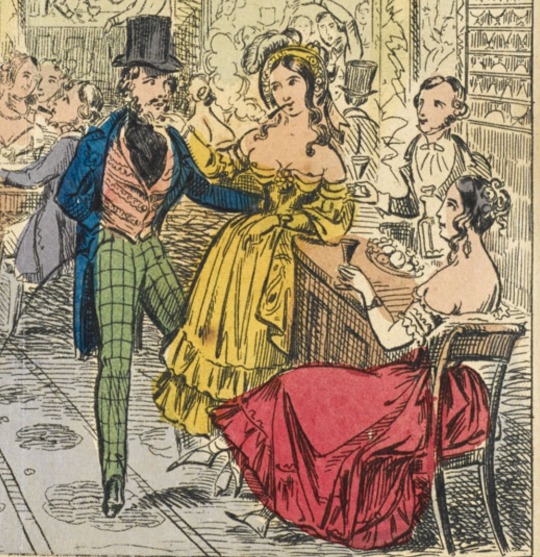
195 notes
·
View notes
Text
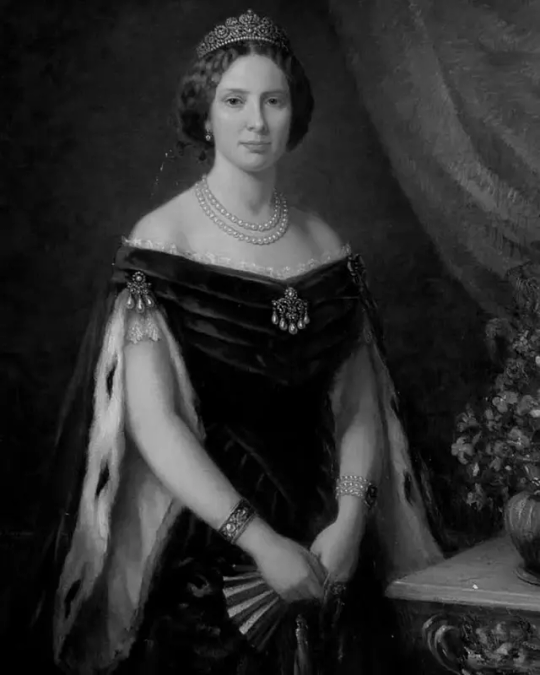



Aug. 5, 1828 - Princess Wilhelmina Frederika Alexandrine Anna Louise (sometimes written as Luise) was born in the Hague as the daughter of Prince Frederik of the Netherlands and Princess Luise of Prussia. Her education was to a large extent entrusted to her Belgian governess and she studied French, German, English, Russian and piano. The latter is something she also continued as an adult.
King Oscar I of Sweden wished to secure connections between the new Bernadotte dynasty and the old dynasties of Europe and a Protestant Princess was also seen as necessary after two Catholic Queens in a row in Protestant Sweden-Norway. Louise fulfilled these credentials, plus a great dowry was expected from the rich House of Orange-Nassau. Therefore, in 1849, Louise was chosen as a suitable bride for the heir to the Swedish throne, Crown Prince Karl.
The Minister of Foreign Affairs began negotiations and a Cabinet Secretary was sent to inspect her. In his report back he let it be known that Louise “had an excellent education and a good character but was not attractive” (quote simplified for clarity). A meeting was arranged between Louise and Karl where reportedly, Louise fell in love and felt an immediate attraction while Karl was disappointed in her appearance. The Crown Prince, however, was convinced to agree to the marriage by his father and the engagement was announced the following year.
During the engagement, Louise studied the Swedish language and history, though she never learnt Norwegian. Upon moving to her new country, her official name was changed to Lovisa.
Lovisa was not considered a social success, her timid and shy nature and tendency to suffer so-called nervous attacks were not appreciated by those of high society, though she had the sympathy and love of the wider Swedish public due to her husband's many and not-so-secret affairs. It was reported in the court chronicle that: “Lovisa could at any time faint and in connection to this, she could have what is called nerve- or cramp-attacks.” While today we may interpret this as epileptic episodes, back then it was interpreted as a hysterical reaction to her husband’s neglect.
Photo 1: Painting of Queen Lovisa from The Royal Court of Norway.
Photo 2: Photograph of Queen Lovisa circa 1860 (photographer unknown, 8.3 x 4.8 cm), from the collection of Prince Albert, the Prince Consort.
Photo 3: Photograph of King Karl XV, Queen Lovisa and their daughter Princess Lovisa (photographer and year unknown).
Photo 4: Portrait of Queen Lovisa by Court Photographer Johannes Jaeger, 1869. Believed to be the oldest Jaeger photograph in the Royal Court's collections, from the Bernadotte Library's archive.
#swedish royal family#queen lovisa#louise of the netherlands#royal history#swedish history#on this day#today in history
35 notes
·
View notes
Text

Edwin Lord Weeks (American, 1849-1903)
Lake at Oodeypore, India
oil on canvas laid down
30 x 49 7/8 in. (76.2 x 126.7 cm.)
Painted circa 1893.
Christie’s
16 notes
·
View notes
Photo

Katsushika Hokusai (1760-1849), Pining for Love (Kinoe no komatsu), Volume Three, 19th century, woodblock-printed illustrated book (ehon), one volume of three, signed Shiunan Ganko, published circa 1814; binding: fukurotoji (pouch binding), blue paper covers, 21.1 x 15.2 cm., 8¾ x 6 in.
132 notes
·
View notes
Note
Was looking at old photograph taken circa early 1880s of the same area where Johannesburg now stands and there's obsoletely nothing beyond plant life there (unlike even nearby Pretoria the local Sotho-Tswana peoples didn't have any settlements in present-day Johannesburg prior to the gold mining) and then a photograph taken circa late 1880 and it like million tents are there (maybe that's an exaggeration). Made me wonder about the last "overnight city" was founded in recent history?
This is a fascinating question!
It's true that the "boom town" phenomena occurs in the case of gold rushes - like California in 1849, West Australia in 1851, the Klondike in 1896 - or the construction of railroads or highways or the development of new factory towns or the like.

I would say that the most recent example of this phenomenon is the "new cities" built in China as speculative real estate developments premised around the need for affordable housing for manufacturing workforces, especially during the 2005-2011 housing bubble. In some years, these developments hit big and you get brand-new megacities out of nowhere.
In the past couple of years, with the slowdown in the Chinese economy and particular problems in the real estate sector, the fascinating phenomena of "ghost cities" (originally observed in 2006) where there are massive empty developments in various stages of construction just lying vacant has become more prominent, as developers run out of money or credit, or find it hard to attract industry and residents in a time of COVID lockdowns and the relative decline of Chinese manufacturing as a basis for urbanization.

20 notes
·
View notes
Text

Exposition Universelle de Paris
Chemins de Fer de l’Ouest
~ Gustave Fraipont (French, 1849-1923), circa 1900
22 notes
·
View notes
Text
Handbook of English Costume in the 19th Century by C. Willett Cunnington and Phillis Cunnington has an eyebrow-raising line about men's pants in the 1840s:
TROUSERS. All through the decade these were tight and generally worn with instep straps; these by 1848 were sometimes made of india-rubber.
At first I misinterpreted this as the trousers were made of rubber: but it's just the instep strap that goes under the shoes, which makes sense! I have long wondered how early to mid-19th century men kept those trouser straps clean—wouldn't they constantly be wet and muddy?
Here's a good look at the trouser instep strap in a circa 1840 cartoon (British Museum). (Also illustrating the dangers of announcing that you become extra bigoted when tipsy).
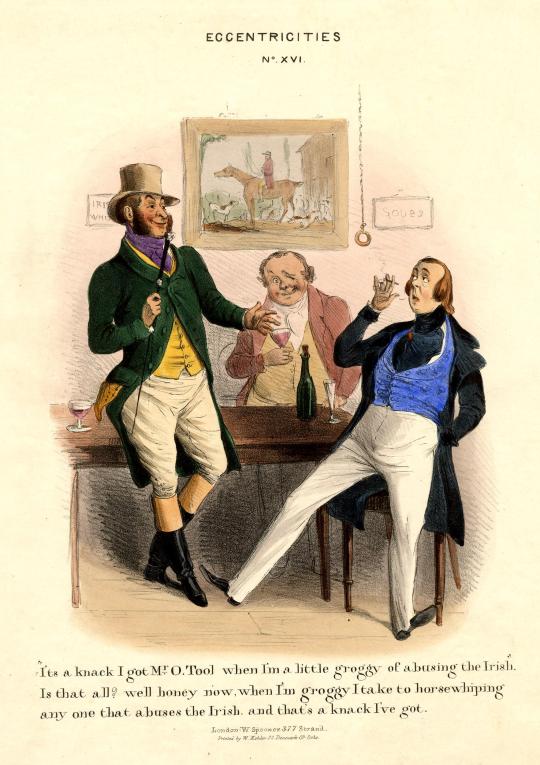
I found several 1849 advertisements for trouser straps in "Cornish's Stranger's Guide Through Birmingham" (Google Books). It reads almost like an 1840s yellow pages, full of advertisements for local businesses.

Absolutely visit the A.P. Dadley manufactory on your next trip to Birmingham! Vulcanised India Rubber trouser straps and Parker's Metallic Oxide paints!
#Eighteen-Forties Friday#1840s#men's fashion#fashion history#trousers#trouser straps#historical men's fashion#victorian#fashion#early victorian era#love the 1840s neckwear on the englishman in the cartoon#also i hope my followers know what yellow pages are#i myself am a relic of a bygone era
49 notes
·
View notes
Photo

Shrike and Bluebird with Begonia and Wild Strawberry (circa 1834) by Katsushika Hokusai (Japanese, 1760–1849).
Woodblock print. Published by Nishimuraya Yohachi.
Image and text information courtesy MFA Boston.
255 notes
·
View notes
Text
Christa Winsloe's maternal aunts: middle names
Also (accidentally): Happy 205th birthday, Ernst Wilhelm Hermann Scherz (Chris' grandfather) 29.12.1818—?.1888 (69 years old)
Chris (Christa Kate Winsloe, 23.12.1888) was born in the same year when her grandfather died, but 99 per cent, the two relatives hadn't lived at the same time at all.
Continuation of THIS post.
Both of youngest sisters had middle name from their Mother (her first), and the first sister had first name that was girl version of the second name of father's (Wilhelm —> Wilhelmine.) Also, Rosalie the good Aunt was named after her aunt (Mum's sister.)
Actually, there are more relative with middle name Wilhelm or Wilhelmine (2 Wilhelmine.)
Bad aunt Wilhelmine Hedwig could be named after the following relatives: a. her father Ernst Wilhelm Hermann, b. her paternal grandmother Johanna Wilhelmine Emile Scherz (née Koeppen (Köppen?)), c. her father's sister Wilhelmine Marie Luise (b. 1816) AND she's also. . .
. . . most likely, a namesake of bad aunt Luise (Tante Luise) as she's named in the book.
Crazy coincidence (or whatever it is): parents of Chris' maternal grandfather had varistions of the same name, Johann Wilhelm (1792–1853) & Johanna Wilhelmine (unknown dates of life)
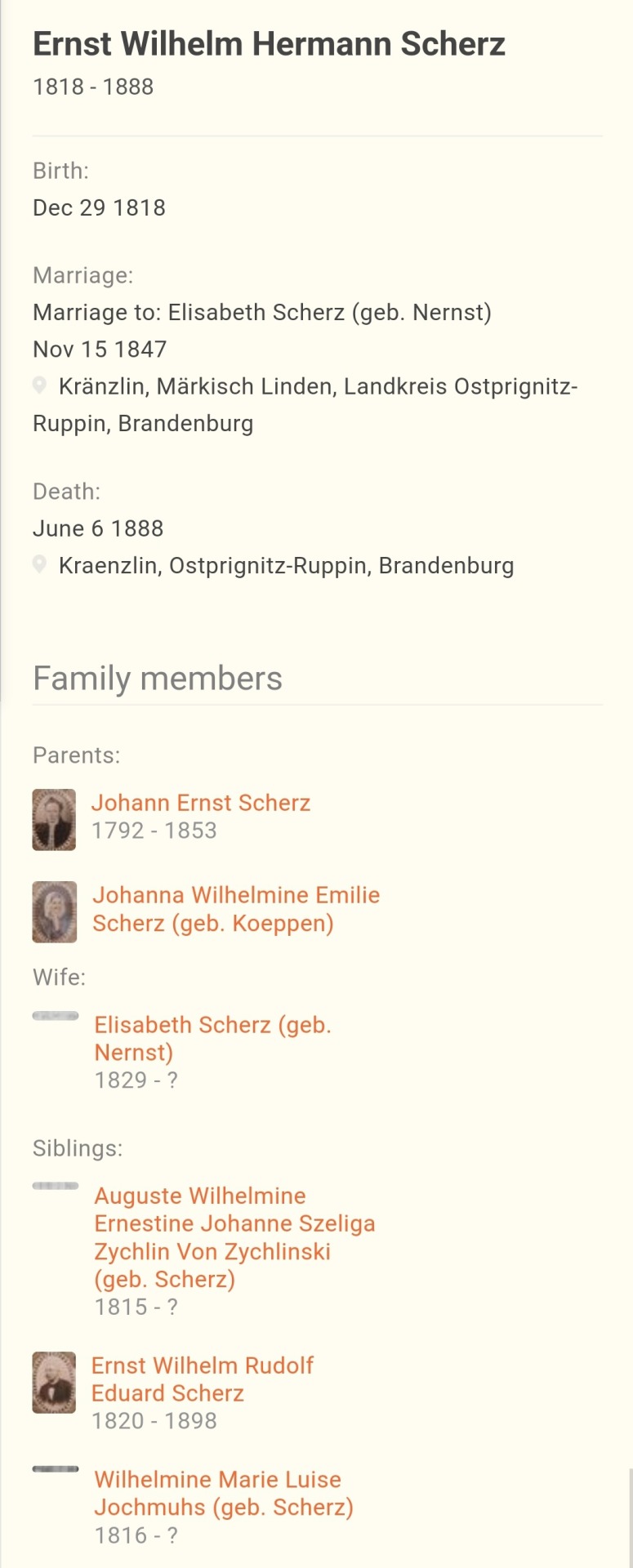
Katharina Elisabeth (Chris' Mum) & Rosalie Elisabeth (good aunt). Their middle name is their Mum's (b. ca. 1829) first name (she had one name only?) AND ALSO, the sisters' grandmother was Elisabeth Nernst (née Baath) (exactly the same name as her daughter, the sisters' Mum.)
Here's the proof of why Rosalie was named so (most likely.) Her maternal aunt Rosalie Scherz (1828–1952) She had been living for 23 or 24 years only. Hopefully, the good aunt Rosalie K. had been living at least three times longer.
Grandparents. Elisabeth (circa 1829) & Ernst Wilhelm Hermann (1888) had 10 or 11 years difference. So, their daughter Katharina Elisabeth's (6 of May, 1859) (Käte in the book) difference with Arthur Winsloe (1849, sometime mid-summer, most likely) (no name in the book, but really, Alfred like the first son) is nearly 10 years doesn't seem a lot for a straight marriage. (Arthur's parents i.e. Chris' paternal grandparents had about 15 years in-between, so it's no wonder why little Tina? had interest in older girls and women too as a child, plus attachment to the one and only Mum. (? = hopefully, correct shortening of the name that Chris gave to self after being able to speak.)
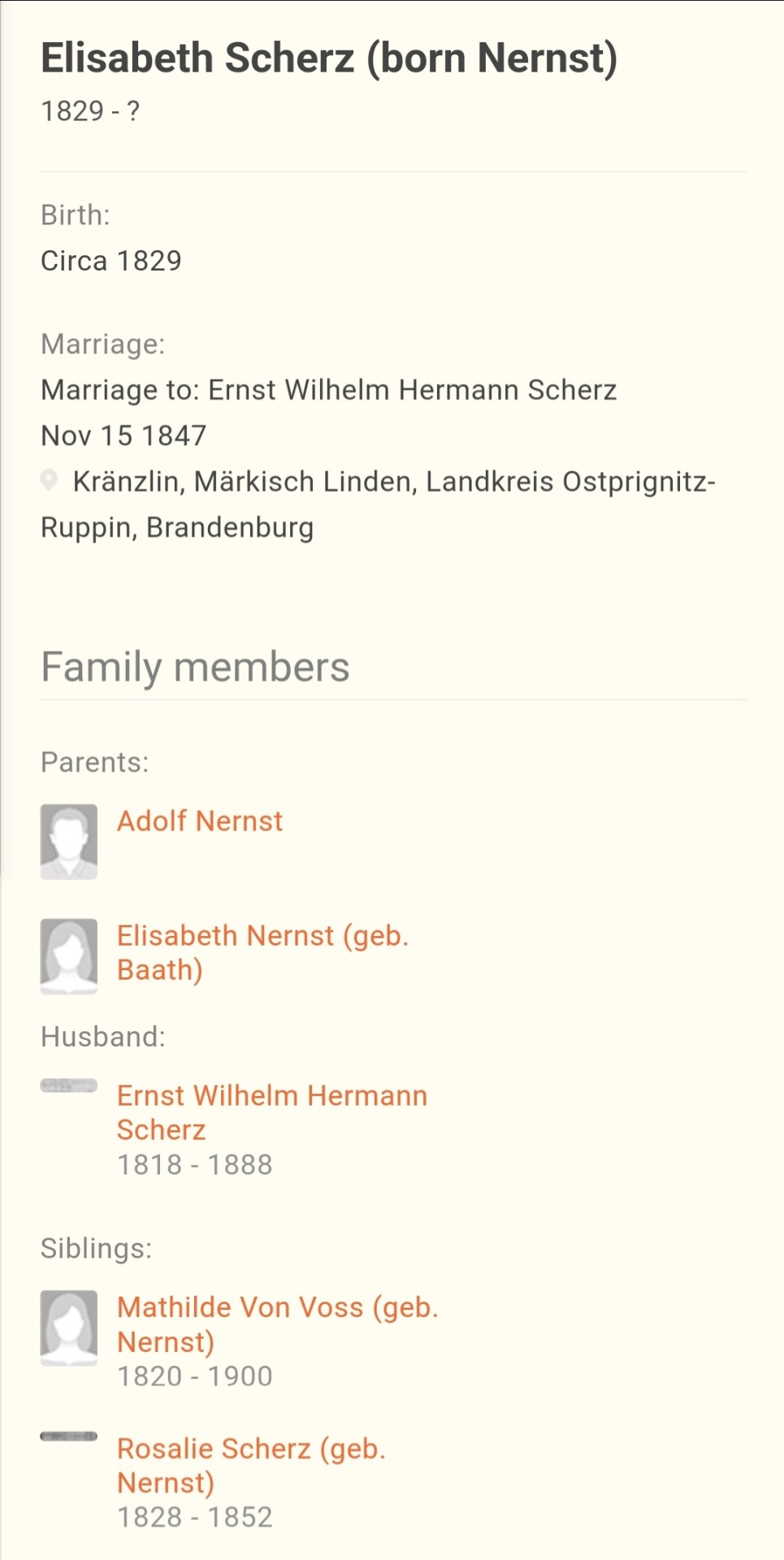
A lot more to come in more than one post. (Paternal side of relatives has looong & a little unfinished research as father's family had 13 children in total (10 is correct when it comes to children born in Scotland.)
EDIT: [THE SCREENSHOT ABOUT ERNST] DON'T PAY ATTENTION TO CHILDREN. The Information has some mistakes (not all 5 children, Catharine instead of Katharina, etc. maybe.)
His death date is 6.6.1888, so of course, he and Chris the granddaughter didn't live at the same time at all.
#Christa Winsloe#The Child Manuela#Mädchen in Uniform#Madchen in Uniform#relatives#Das Mädchen Manuela
4 notes
·
View notes
Text

Bust portrait (circa 1840-1849) of Charles XIV Johan, born Jean Baptiste Jules Bernadotte (1763-1844), King of Sweden and Norway from the 16th century.
#Jean-Baptiste Jules Bernadotte#Jean-Baptiste Bernadotte#maréchal Bernadotte#Karl XIV Johan of Sweden#King Karl XIV Johan#Napoleonic Era#Napoleonic Wars#Napoleon's Marshals
6 notes
·
View notes
Quote
A nonce word tantrum meant penis. In Slang and its Analogues Past and Present (1904), John Stephen Farmer (1854-1916) and William Ernest Henley (1849-1903) mention its occurrence in Burlesque upon Burlesque: or, The Scoffer Scoft. Being some of Lucians Dialogues, newly put into English fustian for the Consolation of those who had rather Laugh and be Merry, then be Merry and Wise (London, 1675), a translation by the English author Charles Cotton (1630-87) of dialogues written in Greek by the satirist Lucian of Samosata (circa 125-180); here, Bacchus tells Apollo that Priapus has sodomised him (nock means bum):
the disputed origin of ‘tantrum’ – word histories
2 notes
·
View notes